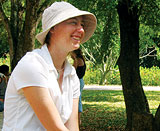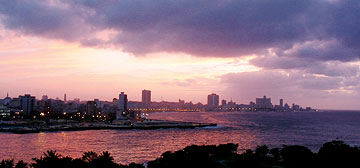Off the Map

I used to think of Cuba as a small island, far, far away from my comfortable life in the Great U.S. of A. It was an exotic place—tropical and communist—forever frozen at that moment in 1959 when bearded revolutionaries on tanks rolled into Havana and put Fidel Castro in power. Certainly no one I knew had ever gone there, if only because of the immovable embargo.
Imagine my surprise to discover as a college student that in fact Cuba is about the size of Florida and only 40 miles off the U.S. mainland. Cuba is closer than Hawaii and home to more than 11 million people, roughly the same population as Ohio.
“Is it because I never had to take geography?” I asked myself. After all, I’ve never had to memorize a capital in my life. When I returned from Cuba, I could see clearly for the first time another culpable party: the weather channel.

When Hurricane Ivan hit Florida this fall, I watched its digitized vortex move across the TV screen and later saw footage of its merciless destruction of the state’s homes and businesses. The hurricane didn’t seem to exist until it hit American shores.
In fact, Huracán Iván tore right through Havana, doing no small damage considering most buildings have been deteriorating for the past 45 years. The city was thrust into rolling blackouts and many businesses and schools were closed for weeks—all of which one would never know from reading the American press.
Media doesn’t just shape our conception of the world; it draws its boundaries. We don’t hear the trees fall in the forest unless the New York Times picks up the story. The Times does not have a correspondent in Cuba.
When I stepped off the plane in Havana, I physically took on a different perspective of the world. No longer was Cuba glossy photos in National Geographic. It was the people I passed on the street, an afternoon thunderstorm, palm trees outside my window. Indeed, it was the United States that was now two-dimensional, appearing only in blurry newspaper photos somewhere far, far away.
When we were in Cuba, we were always starved for news of home. Those rare copies of the New York Times and theEconomist were passed eagerly from hand to hand. It was somehow comforting to know that the “world” still existed. In between, we read the weekly Granma, the official newspaper of the Communist Party, nearly the only source of news in Cuba. Its 12 or so pages were devoted mainly to the party line: Fidel’s denouncement of Yanqui imperialism, coverage of the latest American attacks on Cuba, profiles of exemplary workers.
The strange effect of not hearing much about the United States, the Middle East, Africa, and so on was that these places slowly ceased to exist for me. My world was Cuba, its edges bounded by the turquoise Atlantic Ocean.
Before I arrived, Cuba had been a pastiche of images more than anything else: guerillas crouched in the jungle, Fidel Castro smoking cigars, Che Guevara playing a round of golf at the former Havana Country Club, old Chevies by crumbling buildings, gorgeous women in spandex, people fleeing the island on flimsy rafts, beaches and palm trees, and casinos.
Now I was in the photos. El Instituto Superior de Arte, where we stayed, formerly the elite Havana Country Club, was turned into the country’s top art school after the 1959 revolution. We ate in the dining room each day, looking out over the golf course where Che had played so irreverently. We saw where the guerilla revolutionaries were captured and tortured. We walked in the fortress on the eastern extreme of the island, where pirates had fought and been captured and tortured hundreds of years before. We saw the bay near Columbus’ first landing in the Americas.
It was a return to the origins of history textbooks—the years, events, and people expanded to dimensions inconceivable. The story of Cuba became intertwined with our own stories, the objective became subjective, and the smooth textured.
It would be a long journey back.
More L&C Magazine Stories
Lewis & Clark Magazine is located in McAfee on the Undergraduate Campus.
MSC: 19
email magazine@lclark.edu
voice 503-768-7970
fax 503-768-7969
The L&C Magazine staff welcomes letters and emails from readers about topics covered in the magazine. Correspondence must include your name and location and may be edited.
Lewis & Clark Magazine
Lewis & Clark
615 S. Palatine Hill Road MSC 19
Portland OR 97219

